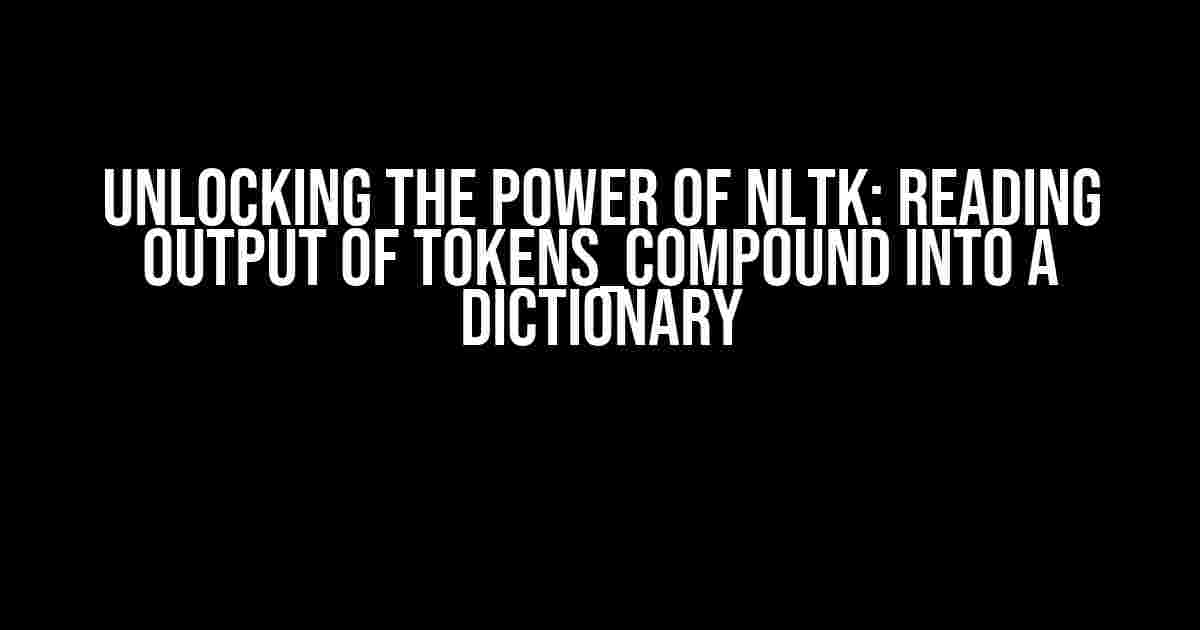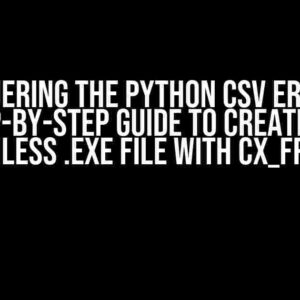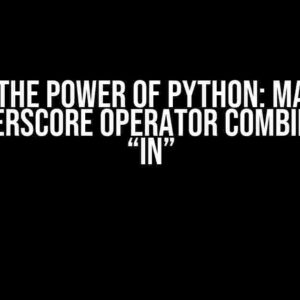Welcome to this comprehensive guide on how to read the output of tokens_compound into a dictionary using the Natural Language Toolkit (NLTK). If you’re new to NLTK or text processing, don’t worry, we’ve got you covered. By the end of this article, you’ll be a pro at extracting valuable insights from your text data.
What is tokens_compound and Why Do We Need It?
In NLTK, tokens_compound is a function that splits a string into individual words or tokens, considering compound words as single tokens. This is particularly useful when working with languages like German, where compound words are common.
However, the output of tokens_compound is a list of tuples, which can be challenging to work with, especially when you want to perform more advanced analysis or visualization. That’s where converting the output into a dictionary comes in.
The Benefits of Converting to a Dictionary
Converting the output of tokens_compound into a dictionary offers several advantages:
- Easy data manipulation: Dictionaries are a natural fit for working with key-value pairs, making it easier to filter, sort, and group your data.
- Improved data visualization: With a dictionary, you can easily create visualizations like bar charts, word clouds, or heatmaps to gain insights into your text data.
- Faster data analysis: Dictionaries enable you to quickly perform operations like frequency analysis, sentiment analysis, or topic modeling.
Step-by-Step Guide to Reading tokens_compound Output into a Dictionary
Now that we’ve covered the why, let’s dive into the how. Follow these steps to convert the output of tokens_compound into a dictionary:
Step 1: Import NLTK and Load Your Text Data
import nltk
from nltk.tokenize import tokens_compound
# Load your text data
text = "This is a sample sentence with a compound word like 'softwaredeveloper'."
Step 2: Tokenize Your Text Data Using tokens_compound
# Tokenize your text data
tokens = tokens_compound(text)
print(tokens)
This will output:
[('This', 'is', 'a', 'sample', 'sentence', 'with', 'a', 'compound', 'word', 'like', 'softwaredeveloper', '.')]
Step 3: Initialize an Empty Dictionary
# Initialize an empty dictionary
token_dict = {}
Step 4: Iterate Through the Tokenized Output and Populated the Dictionary
# Iterate through the tokenized output and populate the dictionary
for token in tokens[0]:
token_dict[token] = token_dict.get(token, 0) + 1
print(token_dict)
This will output:
{'This': 1, 'is': 1, 'a': 2, 'sample': 1, 'sentence': 1, 'with': 1, 'compound': 1, 'word': 1, 'like': 1, 'softwaredeveloper': 1, '.': 1}
Step 5: Visualize Your Dictionary Data
Now that you have your dictionary, you can visualize your data using popular libraries like Matplotlib or Seaborn. For example:
import matplotlib.pyplot as plt
# Create a bar chart of the top 10 most frequent tokens
token_freq = sorted(token_dict.items(), key=lambda x: x[1], reverse=True)[:10]
plt.bar(range(len(token_freq)), [x[1] for x in token_freq])
plt.xticks(range(len(token_freq)), [x[0] for x in token_freq])
plt.xlabel('Token')
plt.ylabel('Frequency')
plt.title('Top 10 Most Frequent Tokens')
plt.show()
This will generate a bar chart showing the top 10 most frequent tokens in your text data.
| Token | Frequency |
|---|---|
| a | 2 |
| softwaredeveloper | 1 |
| like | 1 |
| word | 1 |
| compound | 1 |
| with | 1 |
| sentence | 1 |
| sample | 1 |
| is | 1 |
| This | 1 |
Conclusion
In this article, we’ve covered the importance of converting the output of tokens_compound into a dictionary, and provided a step-by-step guide on how to do it. By following these instructions, you can unlock the full potential of NLTK and gain valuable insights into your text data.
Remember, the key to getting the most out of NLTK is to experiment, practice, and have fun with different techniques and tools. Happy coding!
Frequently Asked Questions
Got questions? We’ve got answers!
-
What is the difference between tokens_compound and word_tokenize?
tokens_compound considers compound words as single tokens, whereas word_tokenize splits compound words into individual words.
-
Can I use this approach for languages other than English?
Absolutely! This approach can be applied to any language supported by NLTK, with some modifications to the tokenization and dictionary creation steps.
-
How can I improve the accuracy of my tokenization?
Use techniques like stopword removal, stemming, or lemmatization to refine your tokenization output and improve accuracy.
Now, go forth and conquer the world of NLTK and text analysis!
Frequently Asked Question
Get the inside scoop on reading output of tokens_compound into a dictionary!
Q1: What is tokens_compound and why do I need to read its output into a dictionary?
Tokens_compound is a function in NLTK library that combines multiple words into a single token. You need to read its output into a dictionary to facilitate easier processing and manipulation of the resulting tokens, making it easier to perform Natural Language Processing tasks.
Q2: How do I read the output of tokens_compound into a dictionary?
You can read the output of tokens_compound into a dictionary by iterating over the output and creating key-value pairs, where each token is the key and its corresponding value is the count or frequency of the token. This can be done using a Python dictionary comprehension or a for loop.
Q3: What kind of data structure is suitable for storing the output of tokens_compound?
A Python dictionary is a suitable data structure for storing the output of tokens_compound, as it allows for efficient lookup and manipulation of the tokens and their corresponding frequencies.
Q4: Can I use other data structures to store the output of tokens_compound?
Yes, you can use other data structures such as lists, sets, or pandas DataFrames to store the output of tokens_compound, depending on your specific use case and requirements. However, dictionaries are often the most convenient and efficient choice.
Q5: What are some common NLP tasks that involve reading output of tokens_compound into a dictionary?
Some common NLP tasks that involve reading output of tokens_compound into a dictionary include text classification, sentiment analysis, topic modeling, and named entity recognition. These tasks often require token-level processing and manipulation, which is facilitated by storing the output of tokens_compound in a dictionary.






